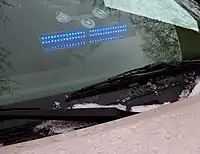Courtesy lights are used to request right-of-way primarily by volunteer or on-call firefighters, emergency medical technicians (EMTs), and other first responders to expedite their response in their privately owned vehicles to their firehouse, base, or directly to the scene of an emergency call. Courtesy lights sometimes allow the user to disobey traffic laws such as speed limits, but usually not laws applying to stop signs or stop lights. Courtesy lights should not be confused with emergency warning lights used in conjunction with audible warning systems (sirens) for emergency vehicles such as police cars, fire apparatus, ambulances, etc, nor should they be confused with warning lights as used by tow trucks, snow plows, construction vehicles and school buses to increase awareness especially when moving slowly or stopped in the roadway.[1]

United States
Laws
A vehicle lawfully displaying courtesy lights is not an emergency response vehicle. In most states, vehicles displaying courtesy lights must still stop at stop signs, red lights, etc. and may not speed or disobey any traffic regulations.[1] Usually, violation ticket fines are increased if the ticketed car was flashing courtesy lights. Laws vary greatly by state.[2]
In most states, other vehicles are not required to yield to the vehicle displaying the courtesy lights, hence the name "courtesy", although laws requiring permits for those using courtesy lights vary by state.
In the state of New Jersey, for instance, users of a volunteer blue light must abide by all traffic laws including speed limit, stop signs, and red lights; however, other non emergency drivers must pull over for a volunteer blue light. State of New Jersey 211th Legislature:[3] "Nothing contained herein is intended to grant to any member of a volunteer fire company or a volunteer first aid or rescue squad any privileges or exemptions denied to the drivers of other vehicles, and such members displaying emergency warning lights and electronic horns shall drive with due regard for the safety of all persons and shall obey all the traffic laws of this State including R.S.39:4-81, provided, however, that the drivers of non-emergency vehicles upon any highway shall yield the right of way to the vehicle of any member of a volunteer fire company or a volunteer first aid or rescue squad displaying emergency warning lights or an electronic horn in the same manner as is provided for authorized emergency vehicles pursuant to R.S.39:4-92."
Police cars, fire trucks, ambulances or other emergency vehicles have sirens and red and blue or red and white or red lights. Private vehicles operated by volunteer fire and rescue squad members (with emergency vehicle identification) responding to an emergency call use blue lights.[4] If an officer pulls a vehicle over for using courtesy lights, the driver will need to provide sufficient identification proving their Emergency Personnel status—badge, ID number, ID card—and their reasoning for usage of courtesy lights.
Ohio is one of the few states that allows the use of sirens in conjunction with lights. Volunteer Firemen and EMTs in the state of Ohio may display red flashing lights and use traditional warning sirens in the same way that a traditional fire apparatus would so long as they pass an inspection by the Ohio State Highway Patrol.
In Virginia, any member of a fire department, volunteer fire company, or volunteer emergency medical services agency and any police chaplain may equip one of their owned vehicles with no more than two flashing or steady-burning red – or red and white combination – warning light units, of types approved by the Superintendent of the State Police.[5]
United Kingdom
In the United Kingdom, courtesy lights may only be used by doctors (registered and qualified) on vehicles, when responding to an emergency.[6] The colour must be green; courtesy lights do not grant any exemptions to traffic laws, similar to many states in the United States. The Road Vehicle Lighting Regulations 1989 grants this lawful excuse to use green lights: "green light from a warning beacon fitted to a vehicle used by a medical practitioner registered by the General Medical Council (whether with full, provisional or limited registration)".[6]
Some doctors work within ambulance services – and ambulances – and therefore some doctors may use blue lights and sirens in this case.[7][8] Alternatively, some vehicles which are ambulances (or used for that purpose) show blue and green lights.[9][10]
See also
References
- 1 2 "Driver's Manual and Study Guide". Retrieved 2009-06-22.
- ↑ "Guide to State Courtesy Light Laws for Volunteer Firefighters". Archived from the original on 2014-05-17. Retrieved 2014-05-15.
- ↑ "Archived copy" (PDF). Archived from the original (PDF) on 2013-01-24. Retrieved 2014-05-04.
{{cite web}}: CS1 maint: archived copy as title (link) - ↑ http://www.state.nj.us/mvc/pdf/Manuals/drivermanual.pdf
- ↑ "46.2-1024. Flashing or steady-burning red or red and white warning light units".
- 1 2 "The Road Vehicles Lighting Regulations 1989".
- ↑ "A Hampshire BASICS (The British Association for Immediate … | UK Emergency Vehicles". Retrieved 2021-02-06.
- ↑ "BASICS Doctor Service". www.retiredambulancepersonnel.co.uk. Retrieved 2021-02-06.
- ↑ Limited, Alamy. "Stock Photo - London Air Ambulance Doctors car in London". Alamy. Retrieved 2021-02-06.
- ↑ "Doctors | UK Emergency Vehicles | Page 2". Retrieved 2021-02-06.